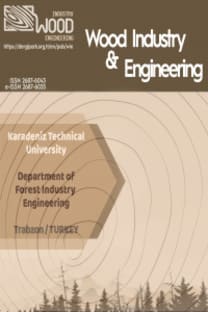EFFECT OF DRYING TYPES AND POLYSTYRENE DENSITY ON THERMAL CONDUCTIVITY OF POLYSTYRENE COMPOSITE PARTICLEBOARD
Thermal conductivity of wood material is superior to other building materials because of its porous structure. Thermal conductivity is a very important parameter in determining heat transfer rate and is required for development of drying models in industrial operations such as adhesive cure rate. Thermal conductivity is used to estimate the ability of insulation of material. Thermal conductivity of wood material has varied according to wood species, direction of wood fiber, resin type, and addictive members used in manufacture of wood composite panels. The aim of the study is to produce a new wood composite material with insulating properties by using insulating material called as polystyrene instead of formaldehyde based adhesives as bonding material. Five different wood species (beech, poplar, alder, pine, spruce), six different polystyrene species with different density values were used in this study and three layers particleboard in 18 mm thickness was produced. Urea formaldehyde resin (UF) was used in conventional panels manufacturing as adhesive. Technical drying was applied half of the test groups, while the other group was conditioned until reach to 12% equilibrium moisture content at room temperature as natural before manufacturing process to determine the effect of drying. The thermal conductivity of new composite panels were determined according to ASTM C 518 & ISO 8301. According to the results from the study, thermal conductivity values obtained from natural drying were found to be higher than technical drying. The type of binder that gives the lowest thermal conductivity values among tree species in natural drying is generally S5. The lowest values in technical drying were obtained from panels bonded with XPS.
___
- Aciu C., Manea D.L., Molnar L.M. and Jumate E. (2015). Recycling of polystyrene waste in the composition of ecological mortars. Procedia Technology, 19, 498-505.
- ASTM C 518 (2004). Methots of Measuring Thermal Conductivity, Absolute and Reference Method. ASTM International: West Conshohocken, USA.
- Aydin I., Demir A., Öztürk H. (2015). Effect of Veneer Drying Temperature on Thermal Conductivity of Veneer Sheets. Pro Ligno, 11(4), 351-354.
- Aydin I., Demirkir C., Colak S. and Colakoglu G. Evaluation of Flours of Different Wood Barks as Filler in Plywood Panels. “Third National Karadeniz Forestry Congress”, Artvin, Turkey, May 20-22, 2010, pp. 1825-1833.
- Bader H., Niemz P., and Sonderegger W. (2007). Untersuchungen zum Einfluss des Plattenaufbaus auf Ausgewählte Eigenschaften von Massivholzplatten. Holzals Roh- und Werkstoff, 65(3), 173–81.
- Cetiner I and Shea A.D. (2018). Wood Waste as an Alternative Thermal Insulation For Buildings, Energy & Buildings 168, 374–384.
- Couturier M.F., George K. and Schneider M.H. (1996). Thermophysical Properties of Wood-Polymer Composites. Wood Science and Technology, 30, 179–196.
- Demirkır C., Colak S. and Aydin I. (2013). Some Technological Properties of Wood–Styrofoam Composite Panels, Composites: Part B, 55, 513–517.
- Dissanayake D.M.K.W., Jayasinghe C. and Jayasinghe M.T.R. (2017). Comparative Embodied Energy Analysis of a House with Recycledexpanded Polystyrene (EPS) Based Foam Concrete Wall Panels, Energy and Buildings, 135, 85–94.
- Fernando P.L.N., Jayasinghe M.T.R. and Jayasinghe C. (2017). Structural Feasibility of Expanded Polystyrene (EPS) Based Lightweight Concrete Sandwich Wall Panels, Construction and Building Materials, 139,45–51.
- Ghani A., Ashaari Z., Bawon P. and Lee S.H. (2018). Reducing Formaldehyde Emission of Urea Formaldehyde-Bonded Particleboard by Addition of Amines as Formaldehyde Scavenger. Building and Environment, 142, 188–194.
- Gonçalves G., Pereira J., Paiva N.T., Ferra J.M., Martins J., Magalhaes F., Barros-Timmons A. and Carvalho L. (2018). Statistical Evaluation of the Effect of Urea-Formaldehyde Resins Synthesisparameters on Particleboard Properties. Polymer Testing, 68, 193–200.
- Horvath J.S. Expanded Polystyrene (EPS) Geofoam: An Introduction to Material Behavior, Geotext. Geomembr. 13 (4) (1994), pp. 263–280.
- Jang M., Shim W.J., Han G.M., Song Y.K. and Hong S.H. (2018). Formation of Microplastics by Polychaetes (Marphysa Sanguinea) Inhabiting Expanded Polystyrene Marine Debris, Marine Pollution Bulletin, 131, 365–369.
- Lakatos A. and Kalmar F. (2013) Investigation of Thickness and Density Dependence of Thermal Conductivity of Expanded Polystyrene Insulation Materials, Materials and Structures 46, 1101–1105.
- Liang W., Lv M. and Yang X. (2016). The Effect of Humidity on Formaldehyde Emission Parameters of a Medium-Density Fiberboard: Experimental Observations And Correlations, Building and Environment 101, 110-115.
- MacLean J. D. Heat. Piping Air Cond.Vol.13 (1941), 380–391.
- Nemli G. and Ozturk I. (2006). Influences of Some Factors on The Formaldehyde Content of Particleboard. Building and Environment, 41, 770–774.
- Resetco C., Frank D., Dikic´ T., Claessens S., Verbrugge T. and Prez F.E.D. (2016). Thiolactone-Based Polymers for Formaldehyde Scavenging Coatings. European Polymer Journal, 82, 166–174.
- Schmidta P.N.S., Cioffia M.O.H., Voorwalda H.J.C. and Silveira J.L. (2011). Flexural Test on Recycled Polystyrene, Procedia Engineering, 10, 930–935.
- Sekino N. (2016). Density Dependence in The Thermal Conductivity of Cellulose Fiber Mats and Wood Shavings Mats: Investigation of The Apparent Thermal Conductivity of Coarse Pores, J. Wood Sci., 62, 20–26.
- Simpson W. and TenWolde. A. Physical Properties and Moisture Relation of Wood. In: Encyclopedia of Wood. Madison, Wisconsin: FPL; 2007 [chapter 3].
- Sonderegger W. and Niemz P. (2009). Thermal Conductivity and Water Vapor Transmission Properties of Wood Based Materials. Eur J Wood Wood Prod., 67, 313–21.
- Sulaiman N.S., Hashim R., Sulaiman O., Nasir M., Amini M.H.M. and Hiziroglu S. (2018). Partial Replacement of Urea-Formaldehyde with Modified Oil Palm Starch Based Adhesive to Fabricate Particleboard, International Journal of Adhesion and Adhesives, 84, 1–8.
- Suleiman B.M., Larfeldt J., Leckner B. and Gustavsson M. (1999). Thermal Conductivity and diffusivity of wood. Wood Sci Technol, 33(6), 465–73.
- Zhou J., Zhou H., Hu C. and Hu S. (2013). Measurement of Thermal and Dielectric Properties of Medium Density Fiberboard with Different Moisture Contents. Bioresources, 8(3), 4185-4192.
- ISSN: 2687-6043
- Başlangıç: 2017
- Yayıncı: Karadeniz Teknik Üniversitesi
